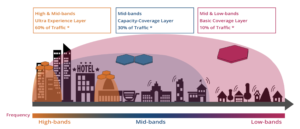-
5G Spectrum
5G extends the catalogue of applicable frequency bands compared to previous cellular network generations.
Deployment in new spectrum bands with wide contiguous blocks of spectrum is key to the success of 5G for both mobile and fixed wireless access, as well as the re-use of existing mobile bands. GSA is tracking the assignment and deployment of 5G spectrum. GSA’s GAMBoD databases provides GSA Members and Associates with information about global spectrum licenses and deployments. Multiple GSA spectrum reports, based on data in GAMBoD databases, are also made freely available via the GSA web page. -
-
5G Advocacy
The GSA Spectrum Group is a global advocacy and technical team supporting the harmonisation and assignment of spectrum in a range of frequency bands for 5G; high-band, mid-band and low-band.
The Spectrum Group operates globally and regionally via dedicated teams and provides input to regulatory engagements and consultations, regulatory and industry initiatives, events, technology education and training. The Spectrum Group also has teams focussed on specific industry topics to develop messaging, initiatives, documents, presentations and regulatory support for the successful global deployment of 5G. -
-
5G spectrum bands
Access to a broad range of spectrum resources is one of the main growth drivers for the deployment of mobile broadband, IoT, and fixed wireless access services; conversely spectrum can also be a limiting factor for the expansion of services into new markets and industries. Different 5G spectrum frequency bands also offer a range of attributes in terms of coverage and capacity.
-
It is important therefore that a broad range of low- to mid- to high-band spectrum is available to deliver mobile services across a wide range of applications that meets the public, private, business and consumer needs in the majority of geographical locations. Access to all three spectrum ranges will enable outdoor and indoor coverage needs to be fully met and the complete set of mass-market 5G services to be provided through a sustainable business model that delivers the best socio-economic value. In addition, spectrum should be made available in a way that uses this finite resource in the most effective and harmonized way globally, in terms of spectrum assignment and technical conditions, without unduly restricting the provision of mobile services in locations where those services are required. Harmonization in this context refers to spectrum assignment as well as technical conditions.

-
Spectrum licensing
The GSA Spectrum team supports regulatory discussions and consultations on the assignment of spectrum to enable 5G.
Since spectrum is a finite resource, GSA advocates the efficient use of all spectrum bands to deliver a broad range of 5G services, from mobile broadband and fixed wireless access, to smart cities, urban and rural areas, as well as industrial and enterprise applications.
4G is extensively deployed around the world, in many cases under technology neutral spectrum licenses. Additional spectrum for 5G has been licensed by countries with operators and enterprises rolling our superfast 5G networks. Administrations and governments are licensing low, mid and high bands spectrum for 5G as the technology continues to be deployed.
GSA advocates technology and service neutral licensing of a sufficient amount of contiguous spectrum for 5G per network, with suitable regulatory conditions, to support the mass market delivery of high bandwidth applications and services. The GSA research team provides a number of resources, to help regulators and administrations understand 5G spectrum requirements, including spectrum reports, spectrum auction tacking and spectrum pricing.
-
-
WRC-23
GSA plays an active role throughout the four-year cycle of the ITU’s World Radiocommunication Conference. The outcomes pave the way for governments and regulators around the world to harmonise frequency bands for ultra-fast IMT/5G services, supporting an expanded global ecosystem and healthy market competition.
At WRC-19, global spectrum regulators identified several millimetre wave frequency bands for 5G IMT, with around 17 GHz of spectrum for 5G in the 26, 40, 45, 47 and 66 GHz ranges identified for IMT, globally or regionally. National administrations also agreed to study, for the next WRC-23 conference, additional spectrum opportunities in the mid-band frequencies between 3.3 and 10.5 GHz, as well as spectrum below 1 GHz. This will help enable 5G services to be further deployed in wider geographical areas, including rural ones, as well as meet the anticipated increased traffic needs of population centres in the latter half of this decade.
The GSA Spectrum Group is now undertaking industry technical and advocacy work as part of the preparations for WRC-23, where additional spectrum are key topics to support future market growth. GSA is continuing to work with national regulators and administrators to harmonise global spectrum across low, mid- and high-band frequencies to ensure mobile services can meet the expanding services both industry and consumers are expecting in the coming years.
-
-
Recent Reports
- View All
-
 Read more
Read moreMobile Spectrum Auctions April-2024
Mobile Spectrum Auctions April-2024 Report summary: This is our April 2024 update on the status of spectrum auctions and assignments…
-
-
 Read more
Read moreIndustry Report Calendar 2024
Industry Report Calendar 2024 Title Due Auction Calendar January 5G…
-
-
 Read more
Read moreSpectrum Pricing January 2024
Spectrum Pricing January 2024 Counting only those auctions and assignments for which GSA has fee data, 2021 saw spectrum auctions…
-




